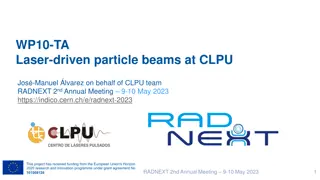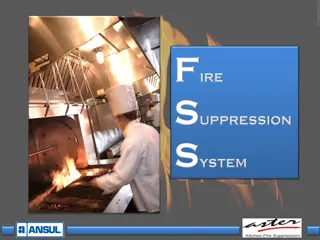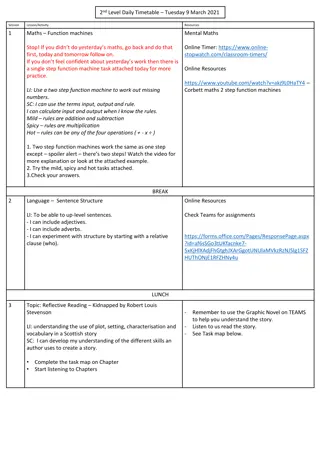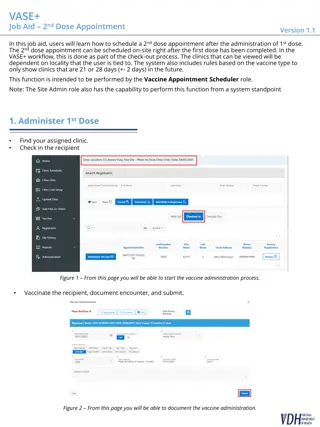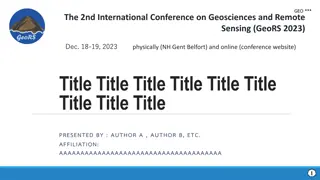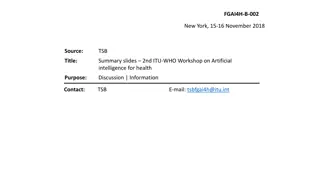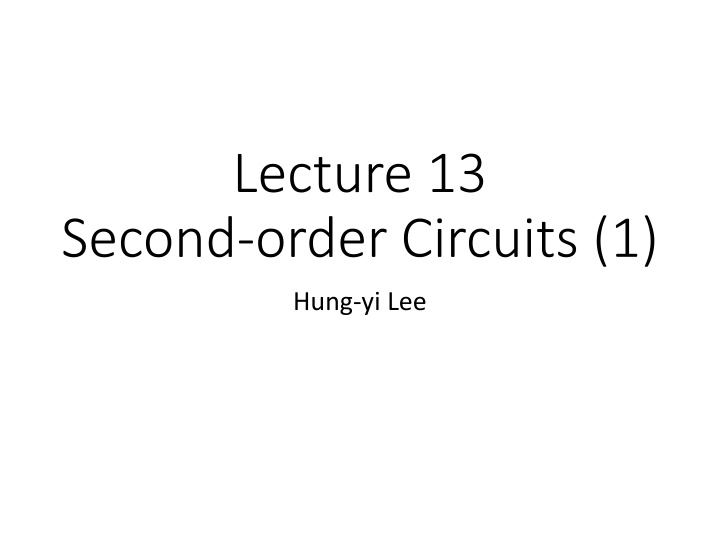
Analysis of Second-Order Circuits Using Differential Equations
Explore the systematic analysis of second-order circuits by solving differential equations, finding natural and forced responses, and determining initial conditions. Follow steps for solving by differential equations, such as listing the differential equation, finding responses, and obtaining the complete response. Mesh and Node Analysis methods are illustrated for circuit analysis.
Download Presentation

Please find below an Image/Link to download the presentation.
The content on the website is provided AS IS for your information and personal use only. It may not be sold, licensed, or shared on other websites without obtaining consent from the author. If you encounter any issues during the download, it is possible that the publisher has removed the file from their server.
You are allowed to download the files provided on this website for personal or commercial use, subject to the condition that they are used lawfully. All files are the property of their respective owners.
The content on the website is provided AS IS for your information and personal use only. It may not be sold, licensed, or shared on other websites without obtaining consent from the author.
E N D
Presentation Transcript
Lecture 13 Second-order Circuits (1) Hung-yi Lee
Second-order Circuits A second order-circuit contains two independent energy-storage elements (capacitors and inductors). Capacitor + inductor 2 Capacitors 2 inductors
Second-order Circuits Steps for solving by differential equation (Chapter 9.3, 9.4) 1. List the differential equation (Chapter 9.3) 2. Find natural response (Chapter 9.3) There is some unknown variables in the natural response. 3. Find forced response (Chapter 9.4) 4. Find initial conditions (Chapter 9.4) 5. Complete response = natural response + forced response (Chapter 9.4) Find the unknown variables in the natural response by the initial conditions
Solving by differential equation Step 1 Step 1: List Differential Equation
Systematic Analysis 1 = = v i dt i C v C C C C C 1 i = = L i v dt v i L L L L L Mesh Analysis 1 = + + = + + v v v v vs i L i R i s L R C C 1 1 R 1 i + i + = + = + v i vs i L Ri idt s L L LC C
Systematic Analysis 1 = = v i dt i C v C C C C C 1 i = = L i v dt v i L L L L L = i C cv Mesh Analysis Find vC: 1 1 R 1 1 R + = + C C C i + i + v v v v = v i s C C C s L 1 L R LC L L LC 1 = + + v v v v i = L i Find iL: s C C C C L L LC
Systematic Analysis v 1 = = v i dt i C v C C C C C 1 = = L i v dt v i L L L L L Node Analysis 1 1 + = + + = + i i i i is v v C v s L R C R 1 L 1 v 1 1 = + + + + = is vdt C v i v v v s L R RC C LC
Systematic Analysis v Systematic Analysis 1 = = v i dt i C v C C C C C 1 = = L i v dt v i L L L L L = L v Li Node Analysis Find iL: 1 1 1 1 1 1 i + L i + L + + = = L i i i v v v s L L L s RC C LC 1 LC RC C LC 1 1 i + = + i i i vC=v Find vC: L s L L RC LC
v1 v2 Example 9.6 Find i2 =1 + is i i v1: 1 L 1 1 1 v v = + = + is v v v 1 2 is v dt 1 1 2 1 R R L R 1 1 = x+ v 2 i i 2i v2: + R 1 R R v v R = + = + 1 2 x v dt v v v 2 1 2 2 R L R L 2 2 x x
v1 v2 Example 9.6 Find i2 1 L R 1 1 1 = + = is v v v i v dt Target: 1 1 2 2 2 R R L 1 + R R = + x v v v Find v2from the left equations 1 2 2 R L 2 x Then we can find i2 Equations for v1and v2
v1 v2 Example 9.6 Find i2 + R R R 1 L R 1 1 = + x v v v dt = + is v v v 1 2 2 R L 1 1 2 R R 2 x 1 + 1 L R R R + R R = + x i v v dt = + x v v v 2 2 s R L 1 2 2 R L 1 2 x 2 x + 1 1 R R R + + Find v2 x v v v 2 2 2 R R R L 2 x
v1 v2 Example 9.6 Find i2 + 1 L R R R = + x i v v dt 1 2 2 = s i v dt R L 2 2 1 2 x L Li + 1 1 R R R = v 1 R 1 L + + x v v v 2 2 2 2 2 R R R L 2 x Replace 2v with 2i + R R R i = + + + x v v v 2 2 2 s L R L L 1 2 1 2 x x
Example 9.7 Please refer to the appendix
Summary List Differential Equations 1 1 1 1 1 R i + + L= + + = i i i v v v v L L s C C C s RC LC LC C L LC L
Solving by differential equation Step 2 Step 2: Find Natural Response
Natural Response The differential equation of the second-order circuits: ( ) t y t y + 2 ( ) ( ) t ( ) t + = 2 0 y f y(t): current or voltage of an element = damping coefficient 0 = resonant frequency
Natural Response The differential equation of the second-order circuits: ( ) t y t y + 2 ( ) ( ) ( ) t y t y t y F N + = ( ) 2 N N + y t y ( ) y t y + F F 2 ( ) ( ) t ( ) t + = 2 0 y f ( ) t ( ) t ( ) t + = 2 0 0 ( ) t y N ( ) t + = 2 0 y f F Focus on yN(t) in this lecture
Natural Response ( ) N t y ( ) t ( ) t N + + ( ) N = 2 0 2 0 y y N = t A y t e yN(t) looks like: Characteristic equation + + = 2 2 0 + + = 2 2 0 ( t t t 2 0 2 0 Ae Ae Ae ) 2 2 0 2 2 4 = = 2 2 0 2 2 = + ( ) t N 2 0 = 2 2 0 1 2 + = t t A A y e e 1 2 1 2
Natural Response = + = 2 2 0 2 2 0 1 2 Overdamped 1 2 Real 2 2 0 = = Critical damped 1 2 2 2 0 1, 2is 0 Underdamped Complex 2 2 0 = 0 Undamped
Solving by differential equation Step 2 Step 2: Find Natural Response Overdamped Response
Overdamped Response = + = 2 2 0 2 2 0 1 2 1, 2are both real numbers 1 2 2 2 0 ( ) t = t A y e yN(t) looks like N ( ) t + = t t A A y e e 1 2 N 1 2
Overdamped Response ( ) t + = t t A A y e e 1 2 N 1 2 2 A 1 A 0 0 t A 2 e 0 1 2 0 2 t A e 1 1
Solving by differential equation Step 2 Step 2: Find Natural Response Underdamped Response
Underdamped = + = 2 2 0 2 2 0 1 2 = 1 j 2 2 0 = 2 0 2 = + 1 2 0 2 1 2 1 = = + 2 0 2 2 0 2 j j 2 1 = + j = j 1 d 2 d = 2 0 2 d
Euler's formula: = cos + Underdamped ejx sin x j x = j = + j 2 d 1 d ( ) t + ( ( A ( A = = = t t A A y e e 1 2 N 1 2 ) t ( )t + ) + + + j j A A e e d d 1 2 j t j t t A e e e d d 1 2 t d ( ) t ) ( ) = + t A cos A A sin y e t j N 1 2 1 2 d A = A yN(t) should be real. 1 2
Euler's formula: = cos + Underdamped ejx sin x j x = j = ( A + j 2 d 1 d ) t d ( ) t ( ) = + + t A cos A A sin y e t j N 1 2 1 2 d jB (no real part) yN(t) should be real. * = A A 1 2 1 1 1 1 = + = A2 a jb A1 a j b 2 2 2 2 = + = A A A A jb a 1 2 1 2
Underdamped = j = ( A + j 2 d 1 d ) t d ( ) t ( ) = + + t A cos A A sin y e t j N 1 2 1 2 d * = + = = A A A A jb a A A 1 2 1 2 1 2 t d ( ) t = + t cos sin y e a t b a and b will be determined by initial conditions N d Memorize this!
Underdamped ( ) a e t cos = t d + t sin y t b N d a b ( ) t = + + 2 2 t cos sin y e a b t t N d d + b L + 2 2 2 2 a b a b a L e ( ) t = + t L cos sin y e t t = a + 2 2 L b L N d d t d ( ) t ( ) t = ( + t cos cos sin sin y t N d ) = t L cos y e t L and will be determined by initial conditions N d
Underdamped t d ( ) t = + t cos sin y e a t b N d ( ) t ( ) = t L cos y e t N d L t L e Lcos
Solving by differential equation Step 2 Step 2: Find Natural Response Undamped Response
Undamped = j = + j 2 d 1 d Undamped is a special case of underdamped. = 1 j = j = 0 d 2 d t d ( ) t = + t cos sin y e a t b N d ( ) t = + cos sin y a t b t N d d ( ) t ( ) = t L cos y e t N d ( ) t ( ) = d L cos y t N
Solving by differential equation Step 2 Step 2: Find Natural Response Critical Damped Response
Critical Damped ( ) t ( ) t ( ) ? = t + a = = t t A A y e e 2 2 0 Overdamped 1 2 N 1 2 t d + t 2 2 0 cos sin y e t b Underdamped N d = yN 2 2 0 Critical damped = = = 2 2 0 1, 2 1 2 ( ) t ( ) t = Not complete = + t t t A ? A A t y e y e e 1 2 N N
Critical Damped (Problem 9.44) ( ) t ( ) t ( ) t ( ) t = + t t = t A2 t y A e e A2 A t ( ( 2 h e 1 N ) ) 2 = t 1 t h e 2 A = - t t h A e 2 e
Solving by differential equation Step 2 Step 2: Find Natural Response Summary
Summary ( ) t ( ) t ( ) t ( ) t + + = 2 0 2 y y y f Fix 0, decrease ( is positive): Critical damped Underdamped Undamped Overdamped 1 1 1 1 1 R i + = + i i i = + + v v v v L s L L s C C C RC LC LC C L L LC Decrease , smaller R Decrease , increase R
Fix 0, decrease ( is positive) The position of the two roots 1and 2. = 2 2 0 1, 2 =0 Undamped
Homework 9.30 9.33 9.36 9.38
Answer 9.30: v1 + 3 v1 + 10 v1 = 0 9.33: yN=a e^(-0.5t) + b te^(-0.5t) 9.36: yN=a e^(4t) + b e(-6t) 9.38: yN=2Ae^(3t) cos (6t+ ) or yN=2e^(3t) (acos6t + bsin6t) In 33, 36 and 38, we are not able to know the values of the unknown variables.
Appendix: Example 9.7
Example 9.7 Mesh current: i1and ic = i i 1i L c ( ) = = = v Kv KRi di KR i 1i ) out x di L c L di di ( ) ( = + 1 c i i i = + R 1 c i L R i i 1 1 c 1 1 c R dt dt dt ) 1 i dt 1 C di di ( ( ) = + + KR 1 c i i dt L R i i 1 c c c dt dt 2 2 di d i di d i ( ) = 1 1 1 c c i RC K LC c 2 2 dt dt dt dt
Example 9.7 L di di ( ) = + 1 c i i i (1): 1 1 c R dt dt 2 2 di d i di d i ( ) = di 1 1 1 c c i RC K LC (2): c 2 2 dt dt dt dt 2 2 di d i d i ( ) = 1 1 1 c c i i RC K LC (2) (1): 1 c 2 2 dt dt dt dt di L di ( ) 1 c i i 1 c R dt dt
Example 9.7 2 2 d i di d i L di ( ) ( ) 0 = + + 1 2 1 1 c c LC RC K i i 1 c 2 2 dt dt R dt dt 2 2 1 2 d i di d i R di ( ) ( ) 0 = + + 1 1 1 c c K i i 1 c 2 2 dt dt RC L dt dt LC 2 1 2 d v dv R ( ) + + = 1 0 out out K v out 2 dt RC L dt LC
Appendix: Figures from Other Textbooks
Acknowledgement (b02) Equation (b02) Equation


